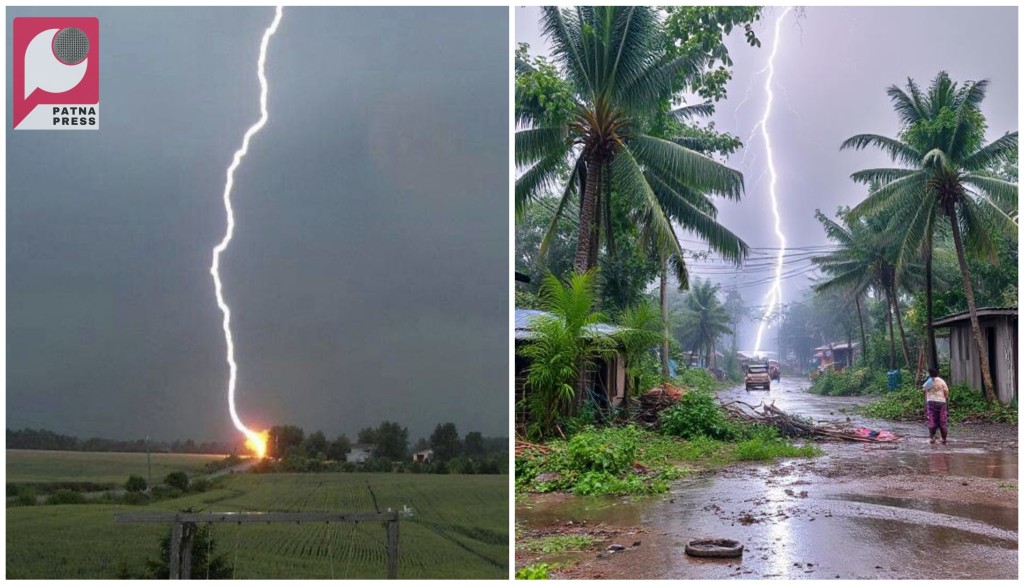
This is an AI-generated image for representation purpose.
Patna : At least 22 people lost their lives in Bihar on Tuesday after a series of lightning strikes across the state, underscoring the region’s growing vulnerability to extreme weather events. The worst-affected districts were Begusarai and Darbhanga, where five deaths were reported in each. Fatalities were also recorded in Madhubani (4), Samastipur (2), Saharsa (2), Aurangabad (2), Lakhisarai (1), and Gaya (1).
The tragedy adds to a grim tally. In the past five years, more than 1,000 people have died due to lightning in Bihar. Last year alone, 242 people were killed, while 253 died in 2022. In 2021 and 2020, the figure was even higher at 280 and 400 respectively, according to the state’s Disaster Management Department.
Bihar ranks second in the country in terms of lightning-related fatalities, with the National Crime Records Bureau reporting that lightning accounts for nearly 39% of deaths from natural disasters across India. Nationally, around 2,500 people are killed by lightning every year.
Why is Bihar so vulnerable?
Experts cite a mix of geographical, climatic and socio-economic factors that make Bihar particularly prone to lightning incidents.
1. Climate and geography:
Bihar’s humid subtropical climate, with high temperatures and monsoonal rainfall, creates ideal conditions for thundercloud formation. The state’s flat terrain and proximity to the Himalayas further intensify storm systems, as cold mountain winds clash with warm, moisture-laden air from the plains.
2. Rural exposure:
A large proportion of Bihar’s population lives in rural areas and depends on agriculture. Many lightning victims are farmers caught in open fields during storms. Unlike cities, villages lack tall structures or lightning conductors, increasing exposure. Sparse tree cover and few permanent shelters exacerbate the risk.
3. Soil and moisture:
Bihar is rich in rivers and water bodies, keeping the soil consistently moist—a factor that enhances conductivity and increases the risk of ground strikes.
4. Climate change:
Weather patterns have become more erratic in recent years. Experts say rising temperatures and unusual wind conditions—likely driven by climate change—have led to a noticeable uptick in extreme weather events, including lightning.
A deadly force of nature
Lightning is among nature’s most violent phenomena. Each bolt can carry up to one billion volts of electricity, with temperatures soaring to 30,000°C—five times hotter than the surface of the sun. When a strike hits, it can destroy trees, ignite fires and kill people instantly. On Tuesday, a lightning strike in Saharsa sparked a fire after hitting a tree.
People in open spaces—such as farmers, construction workers, and children playing outdoors—are most at risk. Enclosed spaces like homes and cars can offer protection, provided one stays away from electrical outlets, water pipes and metal surfaces.
Efforts to reduce lightning deaths
The Bihar government, in collaboration with the Earth Networks, a US-based private company, has installed early-warning lightning sensors in seven districts—Khagaria, Nawada, Rohtas, East Champaran, Patna, Darbhanga, and Purnia. These systems can detect strikes up to 30 minutes in advance, covering a radius of 15–20km.
In a pioneering move, IIT Patna has developed a wearable locket designed to alert wearers of impending lightning. The 43-gram device, named NITISH (Novel Initiative Technological Intervention for Safety of Human Lives), is powered by body heat and does not require charging. Authorities hope it will be a game-changer for rural workers, especially farmers.
How to stay safe during a storm
The National Disaster Management Authority (NDMA) urges the public to follow basic safety measures during thunderstorms:
- Seek shelter indoors immediately. Stay away from open fields, trees, ponds, and metal objects.
- Avoid using phones, electrical appliances or running tap water.
- Close all windows and doors, and avoid terraces or balconies.
- Do not stand near tin roofs or under metal structures.
- When in a vehicle, keep windows shut and avoid touching metal parts.





